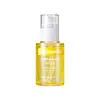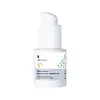What's inside
What's inside
 Key Ingredients
Key Ingredients

 Benefits
Benefits

 Concerns
Concerns

No concerns
 Ingredients Side-by-side
Ingredients Side-by-side

Water
Skin ConditioningButylene Glycol
HumectantGlycerin
HumectantNiacinamide
SmoothingPentylene Glycol
Skin ConditioningPropanediol
SolventChlorella Vulgaris Extract
Skin ConditioningHydrolyzed Jojoba Esters
Skin ConditioningCitrus Aurantium Dulcis Oil
MaskingCitrus Nobilis Peel Oil
MaskingCedrus Deodara Wood Oil
MaskingLavandula Hybrida Oil
EmollientPelargonium Graveolens Flower Oil
MaskingFicus Carica Fruit Extract
HumectantGinkgo Biloba Nut Extract
Skin ConditioningMorus Alba Fruit Extract
AntioxidantPunica Granatum Fruit Extract
AntioxidantGlycereth-26
HumectantGlucose
HumectantCholeth-24
EmulsifyingSodium Polyacryloyldimethyl Taurate
Emulsion StabilisingFructooligosaccharides
HumectantFructose
HumectantTromethamine
BufferingEthylhexylglycerin
Skin Conditioning1,2-Hexanediol
Skin ConditioningAscorbyl Glucoside
AntioxidantTocopherol
AntioxidantCarbomer
Emulsion StabilisingXanthan Gum
EmulsifyingDisodium EDTA
Limonene
PerfumingWater, Butylene Glycol, Glycerin, Niacinamide, Pentylene Glycol, Propanediol, Chlorella Vulgaris Extract, Hydrolyzed Jojoba Esters, Citrus Aurantium Dulcis Oil, Citrus Nobilis Peel Oil, Cedrus Deodara Wood Oil, Lavandula Hybrida Oil, Pelargonium Graveolens Flower Oil, Ficus Carica Fruit Extract, Ginkgo Biloba Nut Extract, Morus Alba Fruit Extract, Punica Granatum Fruit Extract, Glycereth-26, Glucose, Choleth-24, Sodium Polyacryloyldimethyl Taurate, Fructooligosaccharides, Fructose, Tromethamine, Ethylhexylglycerin, 1,2-Hexanediol, Ascorbyl Glucoside, Tocopherol, Carbomer, Xanthan Gum, Disodium EDTA, Limonene
Centella Asiatica Leaf Water 5%
Skin ConditioningNiacinamide 5%
SmoothingMethylpropanediol
SolventBetaine
HumectantWater
Skin ConditioningGlycerin
HumectantPolysorbate 20
EmulsifyingAmmonium Acryloyldimethyltaurate/Vp Copolymer
Polyglyceryl-10 Laurate
Skin ConditioningTetrahydrocurcumin
AntioxidantButylene Glycol
HumectantXanthan Gum
EmulsifyingEthylhexylglycerin
Skin ConditioningAdenosine
Skin ConditioningAnthemis Nobilis Flower Extract
MaskingBeta Vulgaris Root Extract
Skin ConditioningAllantoin
Skin ConditioningCaffeine
Skin ConditioningTocopherol
Antioxidant1,2-Hexanediol
Skin ConditioningCentella Asiatica Leaf Water 5%, Niacinamide 5%, Methylpropanediol, Betaine, Water, Glycerin, Polysorbate 20, Ammonium Acryloyldimethyltaurate/Vp Copolymer, Polyglyceryl-10 Laurate, Tetrahydrocurcumin, Butylene Glycol, Xanthan Gum, Ethylhexylglycerin, Adenosine, Anthemis Nobilis Flower Extract, Beta Vulgaris Root Extract, Allantoin, Caffeine, Tocopherol, 1,2-Hexanediol
Ingredients Explained
These ingredients are found in both products.
Ingredients higher up in an ingredient list are typically present in a larger amount.
1,2-Hexanediol is a synthetic liquid and another multi-functional powerhouse.
It is a:
- Humectant, drawing moisture into the skin
- Emollient, helping to soften skin
- Solvent, dispersing and stabilizing formulas
- Preservative booster, enhancing the antimicrobial activity of other preservatives
Butylene Glycol (or BG) is used within cosmetic products for a few different reasons:
Overall, Butylene Glycol is a safe and well-rounded ingredient that works well with other ingredients.
Though this ingredient works well with most skin types, some people with sensitive skin may experience a reaction such as allergic rashes, closed comedones, or itchiness.
Learn more about Butylene GlycolEthylhexylglycerin (we can't pronounce this either) is commonly used as a preservative and skin softener. It is derived from glyceryl.
You might see Ethylhexylglycerin often paired with other preservatives such as phenoxyethanol. Ethylhexylglycerin has been found to increase the effectiveness of these other preservatives.
Glycerin is already naturally found in your skin. It helps moisturize and protect your skin.
A study from 2016 found glycerin to be more effective as a humectant than AHAs and hyaluronic acid.
As a humectant, it helps the skin stay hydrated by pulling moisture to your skin. The low molecular weight of glycerin allows it to pull moisture into the deeper layers of your skin.
Hydrated skin improves your skin barrier; Your skin barrier helps protect against irritants and bacteria.
Glycerin has also been found to have antimicrobial and antiviral properties. Due to these properties, glycerin is often used in wound and burn treatments.
In cosmetics, glycerin is usually derived from plants such as soybean or palm. However, it can also be sourced from animals, such as tallow or animal fat.
This ingredient is organic, colorless, odorless, and non-toxic.
Glycerin is the name for this ingredient in American English. British English uses Glycerol/Glycerine.
Learn more about GlycerinNiacinamide is a multitasking form of vitamin B3 that strengthens the skin barrier, reduces pores and dark spots, regulates oil, and improves signs of aging.
And the best part? It's gentle and well-tolerated by most skin types, including sensitive and reactive skin.
You might have heard of "niacin flush", or the reddening of skin that causes itchiness. Niacinamide has not been found to cause this.
In very rare cases, some individuals may not be able to tolerate niacinamide at all or experience an allergic reaction to it.
If you are experiencing flaking, irritation, and dryness with this ingredient, be sure to double check all your products as this ingredient can be found in all categories of skincare.
When incorporating niacinamide into your routine, look out for concentration amounts. Typically, 5% niacinamide provides benefits such as fading dark spots. However, if you have sensitive skin, it is better to begin with a smaller concentration.
When you apply niacinamide to your skin, your body converts it into nicotinamide adenine dinucleotide (NAD). NAD is an essential coenzyme that is already found in your cells as "fuel" and powers countless biological processes.
In your skin, NAD helps repair cell damage, produce new healthy cells, support collagen production, strengthen the skin barrier, and fight environmental stressors (like UV and pollution).
Our natural NAD levels start to decline with age, leading to slower skin repair, visible aging, and a weaker skin barrier. By providing your skin niacinamide, you're recharging your skin's NAD levels. This leads to stronger, healthier, and younger looking skin.
Another name for vitamin B3 is nicotinamide. This vitamin is water-soluble and our bodies don't store it. We obtain Vitamin B3 from either food or skincare. Meat, fish, wheat, yeast, and leafy greens contain vitamin B3.
The type of niacinamide used in skincare is synthetically created.
Learn more about NiacinamideTocopherol (also known as Vitamin E) is a common antioxidant used to help protect the skin from free-radicals and strengthen the skin barrier. It's also fat soluble - this means our skin is great at absorbing it.
Vitamin E also helps keep your natural skin lipids healthy. Your lipid skin barrier naturally consists of lipids, ceramides, and fatty acids. Vitamin E offers extra protection for your skin’s lipid barrier, keeping your skin healthy and nourished.
Another benefit is a bit of UV protection. Vitamin E helps reduce the damage caused by UVB rays. (It should not replace your sunscreen). Combining it with Vitamin C can decrease sunburned cells and hyperpigmentation after UV exposure.
You might have noticed Vitamin E + C often paired together. This is because it is great at stabilizing Vitamin C. Using the two together helps increase the effectiveness of both ingredients.
There are often claims that Vitamin E can reduce/prevent scarring, but these claims haven't been confirmed by scientific research.
Learn more about TocopherolWater. It's the most common cosmetic ingredient of all. You'll usually see it at the top of ingredient lists, meaning that it makes up the largest part of the product.
So why is it so popular? Water most often acts as a solvent - this means that it helps dissolve other ingredients into the formulation.
You'll also recognize water as that liquid we all need to stay alive. If you see this, drink a glass of water. Stay hydrated!
Learn more about WaterXanthan gum is used as a stabilizer and thickener within cosmetic products. It helps give products a sticky, thick feeling - preventing them from being too runny.
On the technical side of things, xanthan gum is a polysaccharide - a combination consisting of multiple sugar molecules bonded together.
Xanthan gum is a pretty common and great ingredient. It is a natural, non-toxic, non-irritating ingredient that is also commonly used in food products.
Learn more about Xanthan Gum